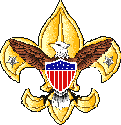| MERIT BADGES |
|
|
|
|
| Note: Eagle Required are in Italics |
"A"
American
Business
American Culture
American Heritage
American Labor
Animal Science
Archaeology
Archery
Architecture
Art
Astronomy
Athletics
Atomic Energy
Auto Mechanics
Aviation
"B"
Backpacking
Basketry
Bird Study
Bugling
"C"
Camping
Canoeing
Chemistry
Cinematography
Citizenship
Community*
Citizenship Nation*
Citizenship World*
Climbing
Coin Collecting
Collections
Communications*
Computers
Cooking
Crime Prevention
Cycling*
"D"
Dentistry
Disability Awareness
Dog Care
Drafting
"E"
Electricity
Electronics
Emergency
Preparedness**
Energy
Engineering
Entrepreneurship
Environmental
Science*
"F"
Family Life*
Farm Mechanics
Fingerprinting
Fire Safety
First Aid*
Fish & Wildlife Mgmt.
Fishing
Fly Fishing
Forestry
"G"
Gardening
Genealogy
Geology
Golf
Graphic Arts
"H"
Hiking
Home Repairs
Horsemanship
"I"
Indian Lore
Insect Studies
"J"
Journalism
"K"
"L"
Landscape Architecture
Law
Leatherwork
Lifesaving**
"M"
Mammal Study
Medicine
Metalwork
Model Design & Building
Motorboating
Music
"N"
Nature
"O"
Oceanography
Orienteering
"P"
Painting
Personal Fitness**
Personal Management*
Pets
Photography
Pioneering
Plant Science
Plumbing
Pottery
Public Health
Public Speaking
Pulp and Paper
"Q"
"R"
Radio
Railroading
Reading
Reptile & Amphibian Study
Rifle Shooting
Rowing
"S"
Safety
Salesmanship
Scholarship
Sculpture
Shotgun Shooting
Skating
Skiing
Small Boat Sailing
Soil & Water
Conservation
Space Exploration
Sports**
Stamp Collecting
Surveying
Swimming**
"T"
Textile
Theatre
Traffic Safety
Truck Transportation
"U"
"V"
Veterinary Medicine
"W"
Water Skiing
Weather
Whitewater
Wilderness Survival
Wood Carving
Woodwork
"X"
"Y"
"Z"
|
|
- Show that you know first aid for injuries or illnesses that could occur while working on the Whitewater merit badge, including hypothermia, heatstroke, heat exhaustion, dehydration, sunburn, insect stings, tick bites, blisters, and hyperventilation.
- Do the following:
- Identify the conditions that must exist before performing CPR on a person. Explain how such conditions are recognized.
- Demonstrate proper technique for performing CPR using a training device approved by your counselor.
- Before doing the other requirements earn the Canoeing merit badge, then do the
following:
- Demonstrate basic canoe-handling skills by completing the Scout Gate Test within 120 seconds while paddling tandem with a buddy.
- Review and compare BSA Safety Afloat and the American Whitewater Affiliation Safety Code and demonstrate your understanding of these principles by answering questions from your counselor.
- Identify and explain the use of safety equipment on running water.
- Explain the International Scale of River Difficulty and apply the scale to the stretch of river where you are practicing and demonstrating your whitewater skills. Identify the specific characteristics of the river that are factors in your classification according to the International Scale.
- Explain how to scout and read a river both while afloat and from ashore. Explain open and closed V's, shoals with broken or dancing water, boils, strainers, broken drops, haystacks, dams, falls and lowhead obstructions, eddies, whirlpools, crosscurrents, flat rocks, standing waves, sheer drops, and heavy water. Demonstrate your ability to read the river where you are practicing and demonstrating your whitewater skills.
- Explain the differences between flatwater and whitewater canoes; identify the advantages and special uses for kayaks and decked canoes in running water. Identify the different materials used in modern whitewater canoe construction and the advantages and disadvantages of each.
- Identify paddles designed for whitewater use and explain their special characteristics.
- Do ONE of the following:
- Demonstrate paddle strokes in the bow position of an open canoe on running water, for forward movement, sideways movement, and backward movement. Repeat in the stern position.
- Demonstrate forward, backward, and sideways movement on running water using a single- or double-bladed paddle in a kayak or decked canoe.
- While paddling aloud or with a partner in an open canoe, or while alone in a kayak, demonstrate forward and back ferry, eddy turn, peeling out of an eddy, and high and low braces.
- Explain and demonstrate:
- Self-rescue and procedures when capsized in running water
- Safe rescue of others in various whitewater situations
- Portaging -- when and how to do it
- The whitewater buddy system using at least three persons and three craft
- Discuss the use of inflatable boats on moving water. Explain how to safely outfit and use an inflatable boat in whitewater including the type of craft suited to certain water conditions, how to maneuver the craft on the water, and what special safety precautions should be taken when using an inflatable boat.
- Explain the risks of "tubing" on moving water.
- Participate in a 1-day whitewater trip for beginners. Help to prepare a written plan specifying route, schedule, equipment, safety precautions, and emergency procedures. Determine local rules and obtain permission from local property owners. Explain what steps you have taken to comply with the BSA Safety Afloat and the American Whitewater Affiliation Safety Code. Execute the plan with others.
|
||||||
Last Update May 15, 2023

.jpg)

 Whitewater
Whitewater